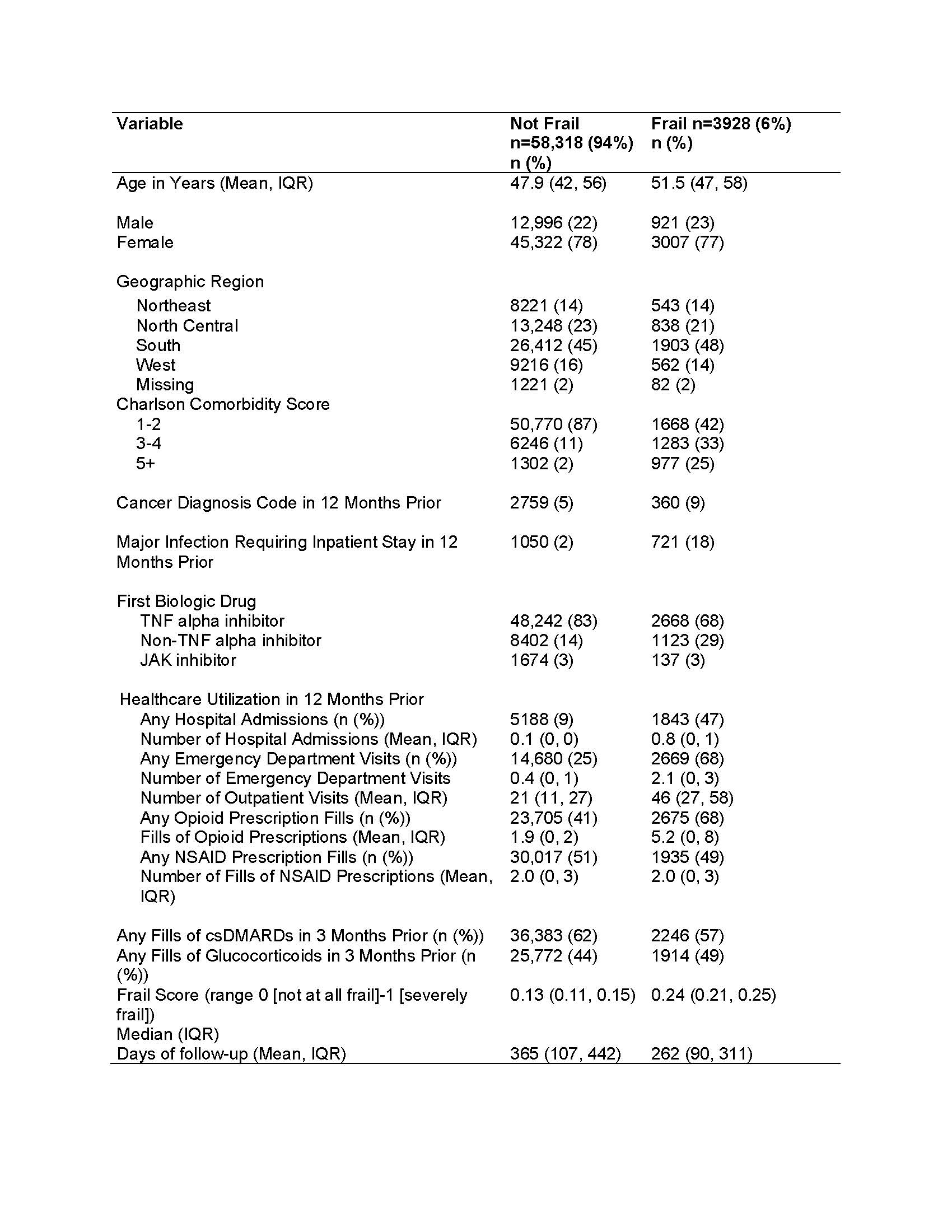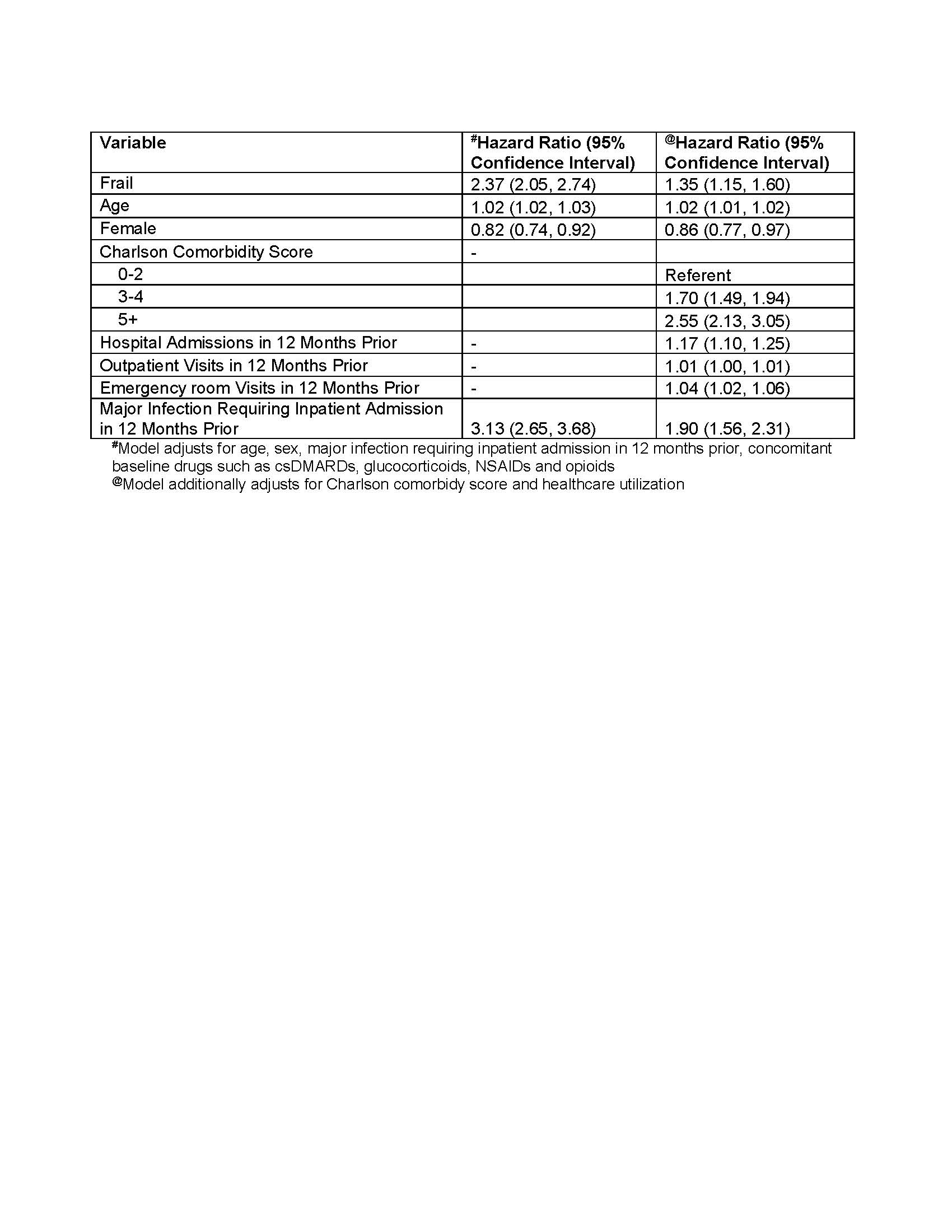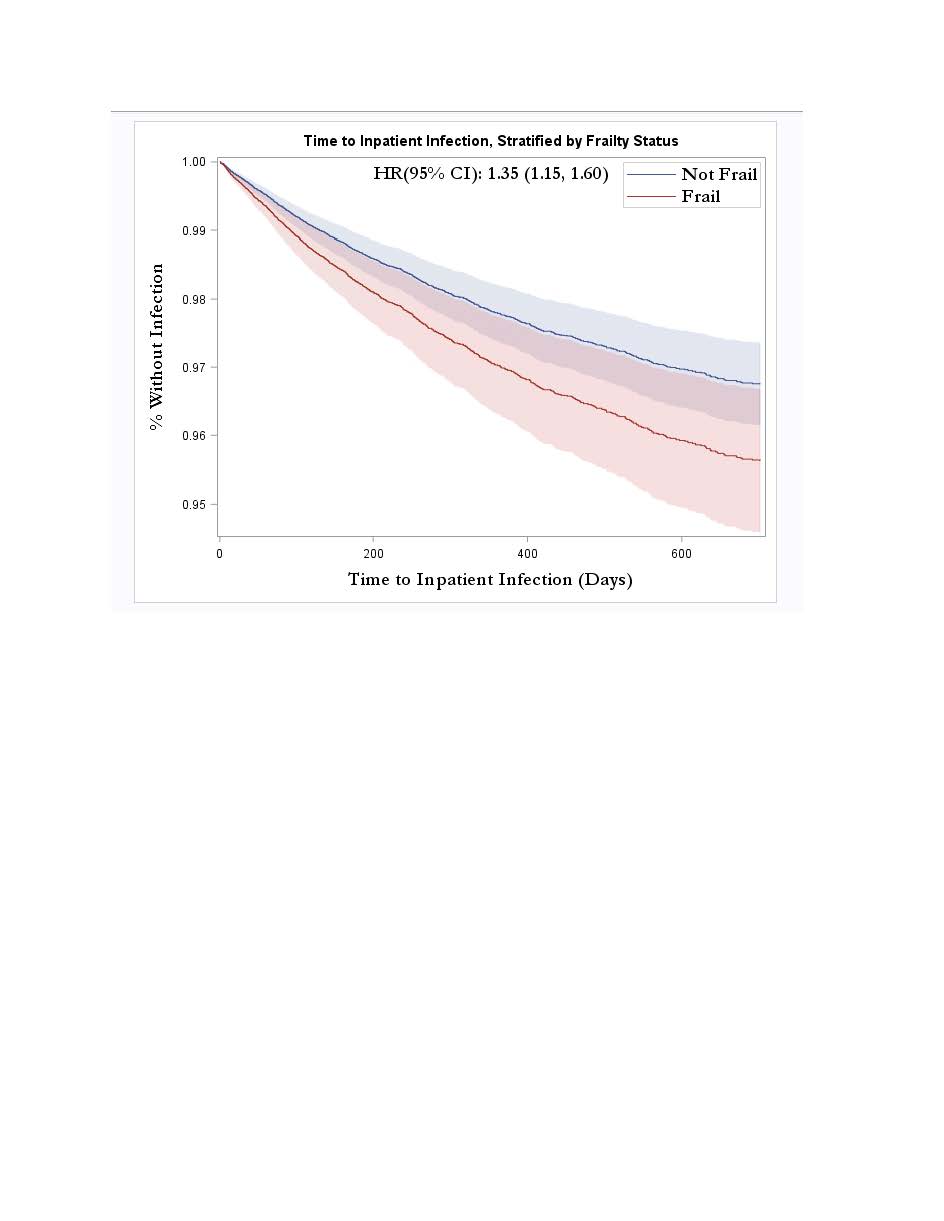Back
Abstract Session
Session: Abstracts: RA – Treatment III: Comorbidities and Consequences (2215–2220)
2218: Frailty Is Associated with Serious Infections in Biologic and Targeted-synthetic DMARD Treated Patients with Rheumatoid Arthritis
Monday, November 14, 2022
3:45 PM – 3:55 PM Eastern Time
Location: Exhibit Hall A
- NS
Namrata Singh, MD, MSc
University of Washington
Bellevue, WA, United States
Presenting Author(s)
Namrata Singh1, Laura Gold2, Katherine Wysham3, James Andrews2, Pankti Reid4, Una Makris5, Bryant England6, Jiha Lee7, Michael George8, Joshua Baker9, Jeffrey Jarvik2, Patrick Heagerty2 and Siddharth Singh10, 1University of Washington, Bellevue, WA, 2University of Washington, Seattle, WA, 3VA Puget Sound/University of Washington, Seattle, WA, 4University of Chicago Medical Center, Chicago, IL, 5UT Southwestern Medical Center and Dallas VA, Dallas, TX, 6University of Nebraska Medical Center, Omaha, NE, 7University of Michigan, Ann Arbor, MI, 8University of Pennsylvania, Philadelphia, PA, 9University of Pennsylvania and Corporal Michael J. Crescenz VA Medical Center, Philadelphia, 10University of California San Diego, San Diego
Background/Purpose: Recently, it has been recognized that frailty and pre-frailty are common in patients with rheumatoid arthritis (RA) [1]. Whether frailty status portends an increased risk of adverse outcomes in patients with RA on biologic or targeted synthetic disease modifying anti-rheumatic drugs (b- or tsDMARDs) remains unknown. Our objective was to evaluate the association between frailty and risk of infections in patients with RA exposed to b- or tsDMARDs.
Methods: Using the IBM/Watson MarketScan® Commercial Claims and Encounters Databases, we identified all patients with RA who filled new prescriptions (or received infusions) for TNFα antagonists (TNFi), non-TNFi biologics (rituximab, abatacept, tocilizumab) or Janus Kinase inhibitors (JAKi) between 2008-2019. The date of the first prescription within these three drug categories was the index date. Patients' frailty risk score was calculated using the Claims-Based Frailty Index (CFI) [2, 3], which estimates a deficit-accumulation frailty index using International Classification of Diseases codes, Current Procedural Terminology codes, and Healthcare Common Procedure Coding System codes in administrative claims data in the 1-year baseline period. The index ranges from 0 (not at all frail) to 1 (severely frail). The primary outcome was time to infections requiring hospitalization. Secondary outcomes included outpatient or inpatient encounters for infections and all-cause hospitalizations.
Patients were followed until 1) outcome occurrence; 2) disenrollment; 3) >90 days elapsed (or >180 days for rituximab) without further fills of the first drug categories; 4) they filled/received infusions of b/tsDMARDs from a different drug category; or 5) 2 years after index. We used Cox proportional hazards adjusting for demographics, calendar year, serious and/or opportunistic infections in the 12-months prior to index to estimate the adjusted hazard ratios (aHR) and 95% confidence intervals (95% CIs) for each outcome. In separate model, we additionally adjusted for comorbidity burden, and health care utilization (HCU).
Results: A total of 62,246 patients with RA met our inclusion criteria of whom 50,910 (82%) started TNFi as their first biologic, 9525 (15%) non-TNFi biologics, and 1811 (3%) JAKi. Among these, 3928 (6%) were considered frail (Table 1). In multivariable analyses, frail patients had higher risk of serious infections compared to non-frail patients (aHR 2.37, 95% CI 2.05-2.74) which decreased to aHR 1.34, 95% CI 1.13-1.58 (Table 2, Figure 1) after adjusting for comorbidity burden and the HCU. Similarly, frailty was associated with increased risk of any infection (aHR 1.18, 95% CI 1.11-1.25), and all-cause hospitalizations (aHR 1.34, 95% CI 1.21-1.49) relative to non-frail individuals.
Conclusion: Frailty is an important predictor for the risk of adverse outcomes among patients with RA treated with b- or tsDMARDs. Our findings underscore the need for considering this parameter in patient evaluations (even among younger patients) in the clinic.
 Table 1. Comparing rheumatoid arthritis (RA) patients who initiated biologic medications who were frail versus not frail.1 1 Frailty defined by the Harvard claims-based frailty index (CFI): https://dataverse.harvard.edu/dataverse/cfi
Table 1. Comparing rheumatoid arthritis (RA) patients who initiated biologic medications who were frail versus not frail.1 1 Frailty defined by the Harvard claims-based frailty index (CFI): https://dataverse.harvard.edu/dataverse/cfi
Abbreviations: csDMARD: conventional synthetic disease modifying anti-rheumatic drugs; IQR: Interquartile range; NSAID: Non-steroid anti-inflammatory drug; TNF: Tumor necrosis factor
 Table 2. Multivariable models evaluating the association between frailty status and inpatient infections
Table 2. Multivariable models evaluating the association between frailty status and inpatient infections
 Figure 1. Kaplan-Meier curves showing time to serious infections stratified by frailty status
Figure 1. Kaplan-Meier curves showing time to serious infections stratified by frailty status
Disclosures: N. Singh, None; L. Gold, None; K. Wysham, None; J. Andrews, None; P. Reid, provisional patent; U. Makris, None; B. England, Boehringer-Ingelheim; J. Lee, None; M. George, AbbVie, GlaxoSmithKlein(GSK), Chemocentryx; J. Baker, Bristol Myers Squibb, Pfizer, CorEvitas LLC, Burns-White, LLC, RediTrex; J. Jarvik, None; P. Heagerty, None; S. Singh, None.
Background/Purpose: Recently, it has been recognized that frailty and pre-frailty are common in patients with rheumatoid arthritis (RA) [1]. Whether frailty status portends an increased risk of adverse outcomes in patients with RA on biologic or targeted synthetic disease modifying anti-rheumatic drugs (b- or tsDMARDs) remains unknown. Our objective was to evaluate the association between frailty and risk of infections in patients with RA exposed to b- or tsDMARDs.
Methods: Using the IBM/Watson MarketScan® Commercial Claims and Encounters Databases, we identified all patients with RA who filled new prescriptions (or received infusions) for TNFα antagonists (TNFi), non-TNFi biologics (rituximab, abatacept, tocilizumab) or Janus Kinase inhibitors (JAKi) between 2008-2019. The date of the first prescription within these three drug categories was the index date. Patients' frailty risk score was calculated using the Claims-Based Frailty Index (CFI) [2, 3], which estimates a deficit-accumulation frailty index using International Classification of Diseases codes, Current Procedural Terminology codes, and Healthcare Common Procedure Coding System codes in administrative claims data in the 1-year baseline period. The index ranges from 0 (not at all frail) to 1 (severely frail). The primary outcome was time to infections requiring hospitalization. Secondary outcomes included outpatient or inpatient encounters for infections and all-cause hospitalizations.
Patients were followed until 1) outcome occurrence; 2) disenrollment; 3) >90 days elapsed (or >180 days for rituximab) without further fills of the first drug categories; 4) they filled/received infusions of b/tsDMARDs from a different drug category; or 5) 2 years after index. We used Cox proportional hazards adjusting for demographics, calendar year, serious and/or opportunistic infections in the 12-months prior to index to estimate the adjusted hazard ratios (aHR) and 95% confidence intervals (95% CIs) for each outcome. In separate model, we additionally adjusted for comorbidity burden, and health care utilization (HCU).
Results: A total of 62,246 patients with RA met our inclusion criteria of whom 50,910 (82%) started TNFi as their first biologic, 9525 (15%) non-TNFi biologics, and 1811 (3%) JAKi. Among these, 3928 (6%) were considered frail (Table 1). In multivariable analyses, frail patients had higher risk of serious infections compared to non-frail patients (aHR 2.37, 95% CI 2.05-2.74) which decreased to aHR 1.34, 95% CI 1.13-1.58 (Table 2, Figure 1) after adjusting for comorbidity burden and the HCU. Similarly, frailty was associated with increased risk of any infection (aHR 1.18, 95% CI 1.11-1.25), and all-cause hospitalizations (aHR 1.34, 95% CI 1.21-1.49) relative to non-frail individuals.
Conclusion: Frailty is an important predictor for the risk of adverse outcomes among patients with RA treated with b- or tsDMARDs. Our findings underscore the need for considering this parameter in patient evaluations (even among younger patients) in the clinic.
 Table 1. Comparing rheumatoid arthritis (RA) patients who initiated biologic medications who were frail versus not frail.1 1 Frailty defined by the Harvard claims-based frailty index (CFI): https://dataverse.harvard.edu/dataverse/cfi
Table 1. Comparing rheumatoid arthritis (RA) patients who initiated biologic medications who were frail versus not frail.1 1 Frailty defined by the Harvard claims-based frailty index (CFI): https://dataverse.harvard.edu/dataverse/cfiAbbreviations: csDMARD: conventional synthetic disease modifying anti-rheumatic drugs; IQR: Interquartile range; NSAID: Non-steroid anti-inflammatory drug; TNF: Tumor necrosis factor
 Table 2. Multivariable models evaluating the association between frailty status and inpatient infections
Table 2. Multivariable models evaluating the association between frailty status and inpatient infections  Figure 1. Kaplan-Meier curves showing time to serious infections stratified by frailty status
Figure 1. Kaplan-Meier curves showing time to serious infections stratified by frailty statusDisclosures: N. Singh, None; L. Gold, None; K. Wysham, None; J. Andrews, None; P. Reid, provisional patent; U. Makris, None; B. England, Boehringer-Ingelheim; J. Lee, None; M. George, AbbVie, GlaxoSmithKlein(GSK), Chemocentryx; J. Baker, Bristol Myers Squibb, Pfizer, CorEvitas LLC, Burns-White, LLC, RediTrex; J. Jarvik, None; P. Heagerty, None; S. Singh, None.

